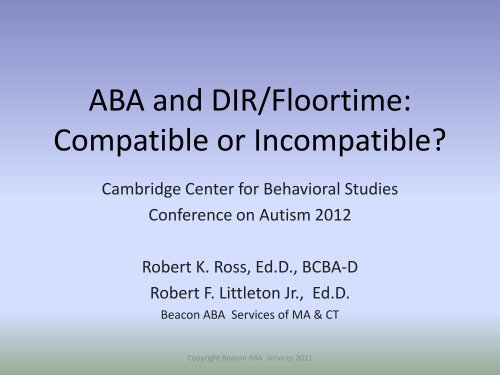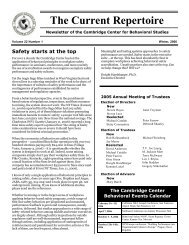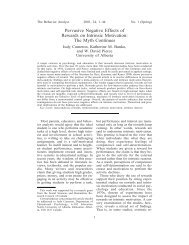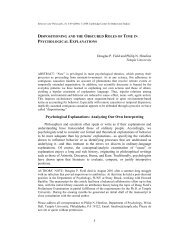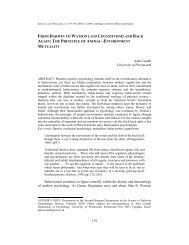ABA and DIR/Floortime - Cambridge Center for Behavioral Studies
ABA and DIR/Floortime - Cambridge Center for Behavioral Studies
ABA and DIR/Floortime - Cambridge Center for Behavioral Studies
You also want an ePaper? Increase the reach of your titles
YUMPU automatically turns print PDFs into web optimized ePapers that Google loves.
<strong>ABA</strong> <strong>and</strong> <strong>DIR</strong>/<strong>Floortime</strong>:<br />
Compatible or Incompatible?<br />
<strong>Cambridge</strong> <strong>Center</strong> <strong>for</strong> <strong>Behavioral</strong> <strong>Studies</strong><br />
Conference on Autism 2012<br />
Robert K. Ross, Ed.D., BCBA-D<br />
Robert F. Littleton Jr., Ed.D.<br />
Beacon <strong>ABA</strong> Services of MA & CT<br />
Copyright Beacon <strong>ABA</strong> services 2011
House Keeping Issues<br />
• A little about my presentation style<br />
• What if you have a question?<br />
• Tone of this presentation<br />
• Is this my opinion?<br />
• Why am I doing this presentation?<br />
Copyright Beacon <strong>ABA</strong> services 2011
Comparison of <strong>ABA</strong> <strong>and</strong><br />
<strong>DIR</strong>/<strong>Floortime</strong><br />
• Philosophical basis <strong>for</strong> these treatment<br />
interventions<br />
• Assessment methods used<br />
• Intervention Goals: How are they developed?<br />
• How are the treatments “operationalized”<br />
– Descriptions of the procedures<br />
• Potential procedural conflicts impacting student<br />
learning<br />
• Ethical questions <strong>for</strong> behavior analysts<br />
Copyright Beacon <strong>ABA</strong> services 2011
EIBI Overview<br />
• Based upon the science of Applied Behavior<br />
Analysis<br />
– Purpose of science: To achieve a thorough<br />
underst<strong>and</strong>ing of the phenomena under study<br />
– Methods:<br />
• Description: Collection of objective facts (reliable)<br />
• Prediction: Accurate facts allow <strong>for</strong> correct predictions<br />
to be made about behavior (not r<strong>and</strong>om)<br />
• Control: We can alter variables to affect rates of<br />
behavior (functional relations)<br />
Copyright Beacon <strong>ABA</strong> services 2011
Early Intensive <strong>Behavioral</strong><br />
Intervention (EIBI)<br />
– Also know as: <strong>ABA</strong>, the Lovaas method, DTT, IBI, IBT, <strong>and</strong><br />
some names I cannot mention<br />
• Components:<br />
– <strong>Behavioral</strong> Emphasis (<strong>ABA</strong>) : Procedures<br />
– 1:1 Instruction<br />
– Comprehensiveness<br />
– Integration<br />
– Individualized treatment interventions<br />
– Family participation<br />
– Intensity: typically 25-40 hours/week<br />
Copyright Beacon <strong>ABA</strong> services 2011
<strong>DIR</strong>/<strong>Floortime</strong> Overview<br />
• D = Functional Developmental levels<br />
• I = Individual differences in sensory processing<br />
• R = Relationship based<br />
• These three elements are “operationalized”<br />
through the implementation of <strong>Floortime</strong><br />
• “A process or concept, through which therapists…<br />
make a special ef<strong>for</strong>t to tailor interactions to the child<br />
at his unique functional developmental level <strong>and</strong><br />
within the context of his processing differences”<br />
Greenspan & Weider (2005)<br />
Copyright Beacon <strong>ABA</strong> services 2011
What is the theoretical basis <strong>for</strong><br />
<strong>DIR</strong>/<strong>Floortime</strong>?<br />
• According to Greenspan & Weider, 2005<br />
– 6 basic developmental skills, or milestones lay the<br />
foundation <strong>for</strong> all of our learning<br />
– In children with ASD “emotional milestones were<br />
missed in the child’s early development”<br />
– “Building these foundations helps children<br />
overcome their symptoms more effectively than<br />
simply trying to change these symptoms alone”<br />
Copyright Beacon <strong>ABA</strong> services 2011
The Six Developmental Milestones<br />
1. Shared Attention <strong>and</strong> Regulation<br />
2. Engagement <strong>and</strong> Relating<br />
3. Purposeful Emotional Interaction<br />
4. Social Problem Solving<br />
5. Creating Ideas<br />
6. Connecting Ideas Together, Thinking Logically<br />
<strong>Floortime</strong> DVD Training Guide, Greenspan & Weider,<br />
2005<br />
Copyright Beacon <strong>ABA</strong> services 2011
Differences in Philosophical<br />
Approach<br />
Copyright Beacon <strong>ABA</strong> services 2011
<strong>DIR</strong>/<strong>Floortime</strong>:<br />
• Starts with an hypothesis of cause (missed<br />
milestones) <strong>and</strong> implements treatment<br />
interventions (<strong>Floortime</strong>) to remediate this<br />
hypothesized* cause.<br />
– If the treatment interventions are not effective, the<br />
cause is still held to be true<br />
– Disconfirming data are not considered evidence<br />
that the underlying hypothesis is incorrect<br />
* NRC report of the Committee on Educational interventions <strong>for</strong><br />
Children with Autism, 2001 (pp 68)<br />
Copyright Beacon <strong>ABA</strong> services 2011
EIBI:<br />
• Starts with assessments an analyses<br />
– to determine variables that affect behavior(s) of concern<br />
• Once these variables are identified, they are used to<br />
develop intervention procedures consistent with basic<br />
principles of learning to build adaptive skills <strong>and</strong><br />
reduce problem behavior<br />
– Assessment first & treatment is developed based upon<br />
evidence of effect<br />
– If the treatment procedures are not effective, the<br />
interventions are modified until positive effects occur.<br />
– Disconfirming data result in modification of hypothesis<br />
Copyright Beacon <strong>ABA</strong> services 2011
Why does Autism Happen? <strong>DIR</strong><br />
• Children require the specific <strong>and</strong> “appropriate<br />
emotional experiences” in their early development. 1<br />
• When their early environments do not provide these<br />
“nurturing interactions” we see the development of<br />
disorders of relatedness. 2<br />
• The result of the ongoing <strong>and</strong> increasing withdrawal is<br />
a lack of opportunity to learn appropriate behavior<br />
<strong>and</strong> skills from other people. 3<br />
1. , 2., & 3., Greenspan & Weider 2005 <strong>Floortime</strong> DVD Training<br />
Guide<br />
Copyright Beacon <strong>ABA</strong> services 2011
Cause 1 Cause 2<br />
Cause 3<br />
Copyright Beacon <strong>ABA</strong> services 2011<br />
Cause 4
Perspective Differences<br />
• Is autism a neurologically based disorder of<br />
unknown etiology?<br />
• Or<br />
• A disorder of “relatedness” that occurs as a<br />
function of the lack of critical emotional<br />
experiences in early development?<br />
Copyright Beacon <strong>ABA</strong> services 2011
Are Philosophical Differences<br />
Important?<br />
• <strong>DIR</strong>/<strong>Floortime</strong> & <strong>ABA</strong><br />
Differ dramatically on why Autism happens?<br />
• Assessment procedures, Goals &<br />
Interventions follow from the hypothesis of<br />
etiology<br />
Copyright Beacon <strong>ABA</strong> services 2011
Assessment<br />
• <strong>DIR</strong>/<strong>Floortime</strong>: “Measurement” is related to<br />
hypothesis of cause<br />
– <strong>DIR</strong>/<strong>Floortime</strong> Developmental Milestones<br />
– Functional Emotional Assessment Scale (FEAS)<br />
• EIBI: Measurement related to per<strong>for</strong>mance of<br />
peers <strong>and</strong> skill sequences<br />
– Norm referenced curricula<br />
– Developmental Sequence curricula<br />
Copyright Beacon <strong>ABA</strong> services 2011
Goals<br />
• How do the two approaches differ with regard<br />
to the types of goals to be addressed in the<br />
context of therapy/instruction?<br />
• Shaped by philosophy<br />
Copyright Beacon <strong>ABA</strong> services 2011
<strong>DIR</strong>/<strong>Floortime</strong>: General goals<br />
• Mastery of both emotional <strong>and</strong> cognitive<br />
abilities at each of nine stages of functional<br />
emotional development *<br />
1) Regulation <strong>and</strong> interest in the world;2)Engaging <strong>and</strong><br />
relating; 3) Intentionality <strong>and</strong> two-way communication;<br />
4) Social problem solving & Shared social problem<br />
solving; 5) Creating symbols & using words & ideas; 6)<br />
Emotional thinking, logic & a sense of reality; 7) Multi<br />
causal & triangular thinking; 8) Gray area, emotionally<br />
differentiated thinking; 9) A growing sense of self <strong>and</strong><br />
reflection on an internal st<strong>and</strong>ard<br />
* Engaging Autism , Greenspan & Weider, 2006<br />
Copyright Beacon <strong>ABA</strong> services 2011
<strong>DIR</strong>/<strong>Floortime</strong>: Specific goals<br />
• Neither the <strong>Floortime</strong> DVD Training Series (<strong>and</strong><br />
accompanying manual) nor “Engaging Autism” the<br />
textbook on using the <strong>Floortime</strong> approach, specify<br />
explicit measurable goals to be addressed<br />
– Broad goal areas that are not operationally defined<br />
<strong>and</strong> subject to significant variability in interpretation<br />
are described e.g.,<br />
• Open <strong>and</strong> close circles of communication”: Build on<br />
the child’s interest <strong>and</strong> then inspire the child to, in<br />
turn, build on what you have done or said”<br />
• “Follow the child’s lead”<br />
Copyright Beacon <strong>ABA</strong> services 2011
EIBI: General goals<br />
• Improve the child’s level of adaptive<br />
functioning compared to typical peers.<br />
• Developed based upon norm <strong>and</strong> criterion<br />
referenced assessments<br />
• Status on level of functioning in skill areas is<br />
objectively quantifiable <strong>and</strong> subject to<br />
independent confirmation<br />
Copyright Beacon <strong>ABA</strong> services 2011
EIBI: Specific goals<br />
• Operationally defined <strong>and</strong> measurable<br />
• Goals relate directly to empirically identified skill<br />
deficits <strong>and</strong>/or behavioral excesses<br />
– Not hypothesized missing levels or sensory<br />
processing dysfunction<br />
• Data are collected, analyzed <strong>and</strong> used to modify<br />
instruction where progress is not being achieved<br />
Copyright Beacon <strong>ABA</strong> services 2011
How are the treatments<br />
operationalized?<br />
Copyright Beacon <strong>ABA</strong> services 2011
“The cornerstone of the <strong>DIR</strong>/<strong>Floortime</strong><br />
treatment program”<br />
<strong>Floortime</strong> (Three elements):<br />
• Parents do <strong>Floortime</strong> with their child creating the kinds of<br />
experiences (undefined) that promote mastery of the<br />
developmental milestones<br />
• Speech, Occupational <strong>and</strong> physical therapist, educators, <strong>and</strong><br />
or psychologists work with the child using specialized<br />
techniques in<strong>for</strong>med by <strong>Floortime</strong> principles to deal with<br />
the child’s specific challenges <strong>and</strong> promote development<br />
• Parents work on their own responses <strong>and</strong> styles of relating<br />
with regard to the different milestones in order to make<br />
their interactions with their child most helpful <strong>and</strong> create a<br />
family pattern that supports emotional <strong>and</strong> intellectual<br />
growth in all family members<br />
Copyright Beacon <strong>ABA</strong> services 2011
<strong>Floortime</strong><br />
• Two goals: (According to Engaging Autism, but not in the DVD<br />
Training Manual)<br />
– Follow the Childs Lead: Harness their natural interests,<br />
join him in his own world<br />
• No specific procedures: Any action can be construed as FCL,<br />
including repeating stereotyped behavior & imitating<br />
aggression (pg 70 Engaging Autism , Greenspan & Weider,<br />
2006)<br />
– Bring the child into a shared world: Not operationally<br />
defined.<br />
• “For a variety of reasons, a child may have elected to be selfabsorbed,<br />
aimless, or seemingly withdrawn into her own<br />
world” (pg. 179, Engaging Autism , Greenspan & Weider, 2006)<br />
Copyright Beacon <strong>ABA</strong> services 2011
D is <strong>for</strong> Developmental (sort of)<br />
• “Underst<strong>and</strong>ing where your child is in his<br />
emotional development is critical to planning<br />
a treatment program”<br />
– Greenspan & Weider (2005). <strong>Floortime</strong> DVD<br />
Training Guide (pg. 1)<br />
• So the developmental level of child will impact<br />
how therapy is conducted.<br />
Copyright Beacon <strong>ABA</strong> services 2011
Gary: Age 22 months<br />
• Expressive Language:<br />
– 1-2 words mostly one word utterances<br />
• Receptive Language: 2-3 words<br />
– Underst<strong>and</strong>s simple concrete object labels <strong>and</strong><br />
actions<br />
– Does not respond to most verbal questions with a<br />
vocal response (@ 99% non-response rate)<br />
– Never observed to answer an open ended<br />
question<br />
Copyright Beacon <strong>ABA</strong> services 2011
• Expressive Language:<br />
Alex 2 years old<br />
– 1-2 words mostly object naming<br />
• Receptive Language: 2-3 words<br />
– Underst<strong>and</strong>s simple concrete object labels <strong>and</strong><br />
actions<br />
– Does not respond to most verbal questions with a<br />
vocal response<br />
– Never observed to answer an open ended<br />
question<br />
Copyright Beacon <strong>ABA</strong> services 2011
• Clip 1<br />
• Clip 2<br />
• Clip 3<br />
Language Level of Instruction<br />
Copyright Beacon <strong>ABA</strong> services 2011
Potential effects on EIBI program<br />
• Practice non-responding to questions<br />
– Systematic Ignore Language Practice (SILP): Making<br />
language an irrelevant stimulus<br />
• Poor responding in instructional sessions where you are<br />
trying to establish stimulus control to “language”<br />
instructions<br />
– Non-responding often produces more interaction<br />
from adults (longer MLU, <strong>and</strong> qualitative changes):<br />
May directly rein<strong>for</strong>ce non-responding<br />
• Decrease in per<strong>for</strong>mance on previously established<br />
responses<br />
• Slower acquisition or failure to acquire responding<br />
Copyright Beacon <strong>ABA</strong> services 2011
Remember: Philosophy Affects<br />
how Treatment Interventions are<br />
Implemented<br />
• “<strong>Floortime</strong> is not about doing a right or wrong<br />
thing it’s a process in which you <strong>and</strong> your child<br />
are always learning” (pg 181,183 &185<br />
Engaging Autism, Greenspan & Weider, 2006)<br />
Copyright Beacon <strong>ABA</strong> services 2011
Video of <strong>DIR</strong>/<strong>Floortime</strong><br />
• Changing behavioral expectations<br />
– Clip 1<br />
• Lack of correspondence between prompts <strong>and</strong><br />
actions of Gary<br />
– Clip<br />
Copyright Beacon <strong>ABA</strong> services 2011
• Clip 1<br />
• Clip 2<br />
Rein<strong>for</strong>ce <strong>Behavioral</strong><br />
Communication?<br />
Copyright Beacon <strong>ABA</strong> services 2011
Possible effects on EIBI program<br />
• Rein<strong>for</strong>cement of behavioral communication:<br />
(reach, grab <strong>and</strong> take)<br />
– Increase in grabbing <strong>and</strong> decrease in use of PECS<br />
or vocal communication procedures being taught<br />
– Increase in aggression when effective<br />
communication system in <strong>DIR</strong>/<strong>Floortime</strong> sessions<br />
is not rein<strong>for</strong>ced in EIBI sessions<br />
– More SILP<br />
Copyright Beacon <strong>ABA</strong> services 2011
“I” is <strong>for</strong><br />
• Individual differences in sensory processing<br />
– Hypothetically, this would result in the parent or<br />
therapist presenting visual, auditory, tactile <strong>and</strong><br />
other sensory stimuli in carefully structured ways<br />
the child based on some assessment of “sensory<br />
processing”.<br />
– Loud, quiet, few words/many, guidelines <strong>for</strong> touch<br />
(soft hard, lots little), etc.<br />
• No evidence of this principle being followed<br />
Copyright Beacon <strong>ABA</strong> services 2011
• Relationship Based:<br />
“R” is <strong>for</strong><br />
• This actually refers to using <strong>DIR</strong>/<strong>Floortime</strong> to<br />
build the relationships of the primary<br />
caregivers <strong>and</strong> the child (not the therapists)<br />
– Pg 1. <strong>DIR</strong>/<strong>Floortime</strong> DVD Training Guide<br />
– You may have been under the impression that this<br />
referred to the relationship between the therapist<br />
<strong>and</strong> the child<br />
• What relationship is being built by SILP?<br />
Copyright Beacon <strong>ABA</strong> services 2011
• Gary 1<br />
• Gary 2<br />
• Gary 3<br />
• Prognosis<br />
Analysis<br />
Copyright Beacon <strong>ABA</strong> services 2011
<strong>DIR</strong>/<strong>Floortime</strong> Procedures<br />
• <strong>Floortime</strong> procedures consist of the following<br />
“interventions”<br />
1. Follow the child’s lead<br />
2. Join in at the developmental level<br />
3. Open <strong>and</strong> Close “Circles of communication”<br />
4. Create a play environment<br />
5. Broaden the child’s interactive environment<br />
6. Tailor your interactions to the child’s individual differences in<br />
auditory processing, visual spatial processing, motor<br />
planning <strong>and</strong> sequencing <strong>and</strong> sensory modulation<br />
7. Simultaneously attempt to mobilize the six functional<br />
developmental levels<br />
Copyright Beacon <strong>ABA</strong> services 2011
Guidelines or Procedures<br />
• Requirement <strong>for</strong> “procedures” to be “technological”<br />
which means:<br />
– All of the procedures used must be completely<br />
identified <strong>and</strong> precisely described<br />
– “play therapy must be described as a set of<br />
contingencies between child response, therapist<br />
response, <strong>and</strong> play materials, be<strong>for</strong>e a statement of<br />
technique has been approached” (Baer, Woolf & Risley,<br />
1968)<br />
• Do the procedures in <strong>Floortime</strong> meet this<br />
requirement?<br />
• Can “procedural fidelity” occur?<br />
Copyright Beacon <strong>ABA</strong> services 2011
Inconsistent Implementation<br />
• What will the effect on learning be if…<br />
– different people do different things each time you<br />
are with them?<br />
– If the adults change response requirements <strong>for</strong><br />
each prompt?<br />
– If some problem behaviors routinely access<br />
rein<strong>for</strong>cement<br />
– If emerging adaptive behaviors fail to access<br />
rein<strong>for</strong>cement?<br />
• “<strong>Floortime</strong> is not about doing a right or wrong thing it’s a process in which you<br />
<strong>and</strong> your child are always learning” (pg 181, 183, & 185, Engaging Autism ,<br />
Greenspan & Weider, 2006 Copyright Beacon <strong>ABA</strong> services 2011
Ethics??<br />
• Right To Effective <strong>Behavioral</strong> Treatment:<br />
– Van Houten, Axelrod, Bailey, Favell, Foxx, & Lovaas, (1988)<br />
• Guidelines <strong>for</strong> Responsible Conduct<br />
– 1.0 : Requirement to use scientifically validated treatment<br />
– 2.10 : Treatment Efficacy<br />
• Sections A – B – C<br />
– Is it an ethically valid position to say that you are tolerant<br />
of this condition or directly supportive of it??<br />
– Does your knowledge of how deleterious it can be to the<br />
client matter?<br />
– What about other BCBA’s doing this treatment?<br />
Copyright Beacon <strong>ABA</strong> services 2011
Intervention Procedure Total Scholarly Journal<br />
<strong>Studies</strong> Identified<br />
<strong>ABA</strong> Procedures<br />
Peer Reviewed Journal<br />
<strong>Studies</strong> Identified<br />
Discrete trial teaching 39 21<br />
Picture Exchange Communication<br />
System (PECS)<br />
27 16<br />
Functional Analysis 1,943 172<br />
M<strong>and</strong> Training 16 4<br />
<strong>DIR</strong>/<strong>Floortime</strong> Procedures<br />
Follow the Child’s Lead 0 0<br />
Circles of Communication 0 0<br />
Broaden the range of processing <strong>and</strong><br />
motor capacities used in interactions<br />
0 0<br />
Functional Emotional Development 0 0<br />
Identification of studies of the target procedure : EBSCO Host 3/5/12<br />
Limiters (whole intervention name in the article title- Must be an actual study of the target procedure),<br />
1990-2112, full text, Scholarly journal<br />
Then only peer reviewed journals<br />
Copyright Beacon <strong>ABA</strong> services 2011
Questions - Discussion<br />
Copyright Beacon <strong>ABA</strong> services 2011


